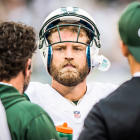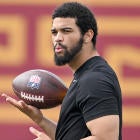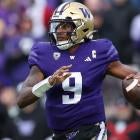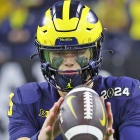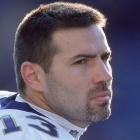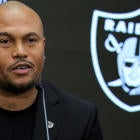In any major pro sport, contract-year performance often makes the difference between getting paid and getting lost. Just ask Doug Martin and Michael Crabtree.
Martin took advantage when the Tampa Bay Buccaneers declined to pick up his 2016 fifth-year option for $5.621 million. He was second in the NFL last season with 1,402 rushing yards and was rewarded with the best running back contract in free agency. Martin re-signed with Tampa Bay for $35.75 million (worth up to $42,937,500 with salary escalators and incentives) over five years, with $15 million fully guaranteed.
Crabtree started on the other side of free agency. He took a one-year, $3.2 million deal (worth a maximum of $5 million through incentives) from the Oakland Raiders because of a tepid free-agent market after taking a back seat to then 34-year-old Anquan Boldin among San Francisco 49ers wide receivers in 2014. Drafted 10th overall in 2009, he bounced back in 2015 -- developing an instant rapport with quarterback Derek Carr. Crabtree signed a four-year, $34 million contract extension containing $16.5 million in guarantees late last season.
With the NFL season at its midpoint, here are five players who are hurting their stock in a contract year. For the 10 players that are boosting their stock, click here. A key 2016 metric or statistic, contract benchmark and probability of hitting this financial target ranging from one dollar sign to four dollar signs is listed for each player.
Stock Down
Key metrics: 56.1 completion percentage, 11 INTs, 68.0 passer rating
Financial benchmark: Chase Daniel ($7M avg/$12M in guarantees)
Probability: $
Fitzpatrick's lackluster play during a disastrous 1-5 start prompted coach Todd Bowles to bench him in favor of Geno Smith. The benching didn't last long, because Smith suffered a season-ending knee injury two quarters into his first start. The Jets are on a two-game winning streak but Fitzpatrick is last in the league in passer rating and completion percentage while leading it in interceptions.
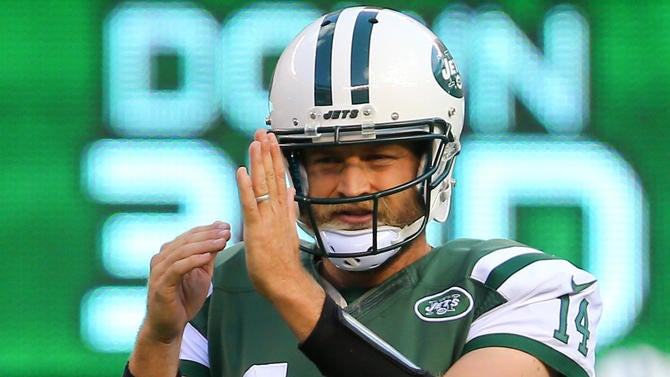
The journeyman's days as a starting quarterback likely are over after this season. Top backup money ($7 million to $7.5 million per year with incentives and salary escalators that could make a two- or three-year deal as much $12 million per year) could be a stretch unless Fitzpatrick can consistently perform like he did in the second half of last week's game vs. the Browns. He completed 13 of 20 passes for 198 yards with a touchdown and no interceptions.
Key metrics: 82nd-ranked CB by Pro Football Focus
Financial benchmark: Janoris Jenkins ($12.5Million-avg/$28.8M in guarantees)
Probability: $
An agreement for an extension couldn't be reached before the season because Gilmore reportedly wanted Josh Norman money. The Washington Redskins made Norman the NFL's highest paid-cornerback on an extremely front-loaded five-year, $75 million deal containing $50 million in guarantees after the Panthers rescinded his franchise tag.
Coach Rex Ryan suggested Gilmore could be a shutdown cornerback similarto Darrelle Revis in his days with the Jets when Ryan was hired in 2015. Revis is still an apt comparison because Gilmore is performing like the 2016 version, who looks like he is on his last legs, instead of the NFL's preeminent cover man. Using a franchise tag, which projects to approximately $14.3 million, seems unnecessary given Gilmore's play.
Key metrics: Fourth in team receptions (19), receiving yards (257)
Financial benchmark: Marvin Jones ($8M avg/$20M in guarantees)
Probability: $
Floyd never has built upon his breakout season in 2013, when he caught 65 passes for 1,041 yards, and this is the worst season of his five-year pro career. Not only is he on pace for career lows in receptions and receiving yards before being further slowed by a hamstring injury, Floyd was losing playing time to J.J. Nelson and Jaron Brown, who recently suffered a season ending ACL tear.

Floyd rebounded from a slow start in 2015 to have three 100-yard receiving games during December. Performances like that may be the only thing to keep Floyd from a one-year, prove-it deal similar to Crabtree's because the long-term market is unlikely to be available.
Key metrics: Leads team in rushing yards (279), rushing TDs (5)
Financial benchmark: Lamar Miller ($6.5M avg/$14M in guarantees)
Probability: $
Murray's workload has decreased because of rookies DeAndre Washington and Jalen Richard. This should prevent Murray from wearing down late in the season like he did in 2016, when he became Oakland's first 1,000 yard rusher since 2010 (Darren McFadden). However, two factors complicate Murray's earning power in Oakland: A hefty extension coming up for emerging QB Derek Carr and All-Pro defensive end/linebacker Khalil Mack potentially becoming the league's highest-paid non-quarterback within the next couple of years.
Key metric: 9 QB pressures allowed
Financial benchmark: Jared Veldheer ($7.3M avg/$17M in guarantees)
Probability: $
The Vikings took a wait-and-see approach with Kalil, whose 2016 option year salary is $11.096 million, while fellow 2012 first-round pick Harrison Smith received a five-year extension which briefly made him the NFL's highest-paid safety. Kalil's 2016 season ended after two games because of a hip injury. Now Kalil has no chance of displaying the form that made him a Pro Bowl alternate in 2012. It may make sense for Kalil to follow the lead of offensive tackles Russell Okung and Kelvin Beachum, who suffered serious contract-year injuries. Okung signed a one-year, $5 million deal (worth up to $8 million through incentives) with the Broncos in the offseason, giving them an option for an additional four years worth $48 million.






















